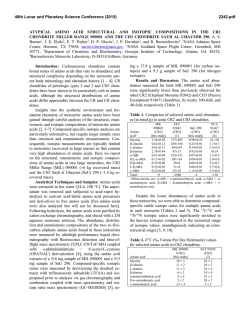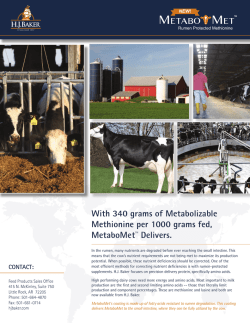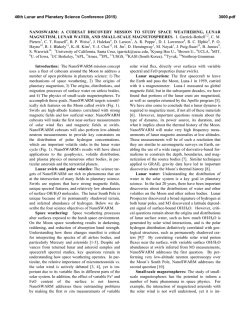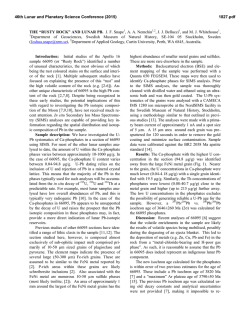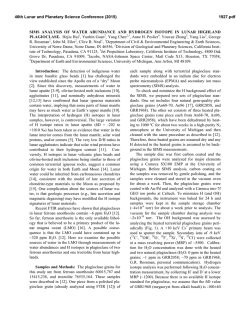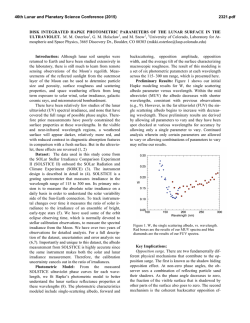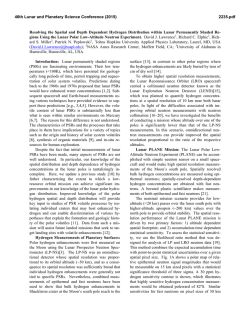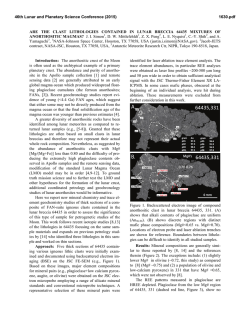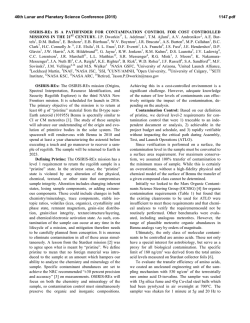
DISTRIBUTION AND ORIGIN OF AMINO ACIDS IN - USRA
46th Lunar and Planetary Science Conference (2015) 1945.pdf DISTRIBUTION AND ORIGIN OF AMINO ACIDS IN LUNAR REGOLITH SAMPLES. J.E. Elsila1, M.P. Callahan1, D.P. Glavin1, J.P. Dworkin1, H.L. McLain,1,2 S.K. Noble1, and E.K. Gibson, Jr.3, 1NASA Goddard Space Flight Center, Greenbelt, MD 20771, 2Catholic University of America, Washington, DC 20064, 3ARES, NASA Johnson Space Center, Mail Code XI3, Houston, TX 77058. Email: [email protected] Introduction: The existence of organic compounds on the lunar surface has been a question of interest from the Apollo era [1] to the present [2]. Investigations of amino acids immediately after collection of lunar samples yielded inconclusive identifications (e.g. [3,4]), in part due to analytical limitations including insensitivity to certain compounds, an inability to separate enantiomers, and lack of compound-specific isotopic measurements. It was not possible to determine if the detected amino acids were indigenous to the lunar samples or the result of terrestrial contamination. Recently, we presented initial data from the analysis of amino acid abundances in 12 lunar regolith samples and discussed those results in the context of four potential amino acid sources [5]. Here, we expand on our previous work, focusing on amino acid abundances and distributions in seven regolith samples and presenting the first compound-specific carbon isotopic ratios measured for amino acids in a lunar sample. Analytical techniques and samples: We analyzed seven samples allocated from the lunar collection at NASA Johnson Space Center (Table 1). Samples were chosen to reflect a range of maturities as measured by Is/FeO ratio [6] and included two samples that were collected to test exposure to lunar module exhaust. Most sample were in the 0.2 to 0.5 g range, with three larger samples (9 to 12 g) allocated for in-depth and isotopic analyses. A subsection of the large allocation of Apollo 70011 was analyzed separately to be compared with the analysis of a previous small allocation. Regolith samples were analyzed using previously published methods [7] to determine amino acid abundances and distributions. Total amino acid content was Table 1. Lunar samples investigated in this study Sample Is/FeO ratio [6] Masses analyzed (maturity) (g) 16, immature 73131 0.33c 18, immature 73241 0.27c 36, submature 78501 0.46 54, submature 70011a 0.27c, 0.49d, 9.28 81, mature 72501b 0.29c, 9.84 92, mature 78421 0.25c 92, mature 69961 11.82 a Collected beneath lunar module (LM) as exhaustexposed sample; bCollected 6.5 km from LM as exhaust control; cBoth hydrolyzed and unhydrolyzed extracts analyzed; dSubsection of larger sample analyzed separately measured from acid-hydrolyzed water extracts of all samples, while the free amino acid content was determined from unhydrolyzed extracts for select samples. Compound-specific carbon isotopic analysis was performed on the large sample of Apollo 70011 using previously published methods [8]. Results and Discussion: Amino acid content: As we previously reported, a suite of amino acids were observed at low concentrations ranging from 105 to 1910 ppb in the hydrolyzed lunar regolith samples [5]. These amino acids include glycine, β-alanine, D- and Lalanine, and ε-ACA. In addition, several other amino acids were detected in one or more samples, including α-aminoisobutyric acid (AIB), D-and L-β-amino-nbutyric acid, α-amino-n-butyric acid, γ-amino-nbutyric acid (γ-ABA), D-and L-aspartic acid, glutamic acid, D- and L-serine, L-threonine, and L-valine. We have now more closely analyzed the variability and distributions of the amino acids, investigating differences not only between different lunar regoliths but also within subsamples of a single regolith sample. For example, sample 70011 was originally collected during the Apollo 17 mission as a 440.70 g unsieved soil sample. We first analyzed a 0.27 g portion of this soil. We were then allocated a larger (9.77 g) sample, of which we initially analyzed 0.49 g. We then split the remaining 9.28 g into 10 aliquots for extraction, hydrolysis, and analysis. The amino acid abundances and distributions in these 12 separate analyses varied, implying that the amino acid contents of the samples are heterogeneous on at least the 0.5 to 1 g scale. We observed variability in both the relative and absolute abundances of amino acids. For example, the concentration of glycine ranged from 1 ppb to 48 ppb, while the β-alanine:glycine ratio varied from 0.15 to ~1. This variability implies that the amino acids are distributed heterogeneously throughout the soil. This could indicate the presence of small carbonaceous particles mixed inhomogeneously through the regolith or could reflect different exposures of portions of the soil sample to sources of amino acids. Compound-specific carbon isotopic analysis: We combined seven of the 10 extracts of the 9.28 g Apollo 70011 sample for compound-specific carbon isotopic measurements. There were sufficient concentrations of glycine, β-alanine, and L-alanine for duplicate measurements; concentrations of other amino acids were too low for analysis. The δ13C value for each of these three 46th Lunar and Planetary Science Conference (2015) amino acids was in the -20 to -30‰ VPDB range. These are the first compound-specific isotopic measurements of an organic compound in a lunar sample. Probable sources of detected amino acids: We considered four potential sources for the amino acids in the lunar samples: (1) terrestrial contamination during the sample acquisition, handling, or curation process; (2) contamination from the lunar module (LM) exhaust, which could implant HCN or other amino acid precursors that would produce amino acids during sample workup; (3) solar wind implantation of amino acid precursors such as HCN; and (4) meteoritic infall to the lunar surface. We previously noted that the amino acid content of Apollo 70011 and Apollo 78501 were similar, despite the fact that 70011 was deliberately collected below the LM exhaust and 78501 was collected 6.5 km away to serve as a control [5]. This suggests that contamination from the LM exhaust was not the primary origin of the observed amino acids. Our current measurements allow us to discuss the other potential sources in more detail. If H, C, and N atoms were implanted by the solar wind and subsequently formed HCN or other amino acid precursors, we would expect the carbon isotopic signature of the amino acids to reflect that observed in the solar wind. The solar wind is depleted in 13C, with a δ13C value of -105‰ ± 20‰ [9]. This value does not agree with the values we measured in sample 70011. In addition, exposure to the solar wind, as measured by maturity, should also correlate with the amino acid abundances in the lunar regolith samples. We found, however, that the least mature samples, with the lowest surface exposure to the solar wind, contained the highest amino acid concentrations. These data, therefore, strongly suggest that solar wind implantation is not the primary source of amino acid precursors. Two potential sources remain: meteoritic infall and terrestrial contamination. Meteoritic infall has been argued to be the source of complex organic material recently analyzed in Apollo 17 samples [2], with the carbonaceous chondritic component of lunar soils estimated at 1-4% [10]. The carbon isotopic composition of glycine, β-alanine, and L-alanine in carbonaceous chondrites, however, is typically in the +10 to +50‰ range. Our measured values of -20 to -30‰ in Apollo 70011 [11] are in closer agreement with those of amino acids measured from terrestrial biological sources, which are typically in the -70 to +11‰ range [12]. Thus, it appears that the primary source of at least the glycine, β-alanine, and L-alanine measured in these samples is likely terrestrial in nature. Figure 1 summarizes the measured isotopic data and comparisons with possible sources. 1945.pdf Apollo 70011 Solar Wind Meteoritic Terrestrial -150 -100 -50 0 50 δ13C (‰ VPDB) 100 Figure 1. Range of carbon isotopic ratios measured for Apollo 70011 amino acids compared with solar wind, carbonaceous chondrites, and terrestrial biological sources. We cannot rule out meteoritic infall as a contributing source to the detected amino acids, however. The presence of AIB in our analyses, which was also tentatively identified in a previous study of sample 78421 [13], may suggest some meteoritic contributions to the amino acid content; AIB is a common meteoritic amino acid that is rare in the terrestrial biosphere and is often used to argue for the indigenous nature of amino acids in carbonaceous chondrites. The most likely conclusion from our analyses is that the amino acids detected in these lunar samples are primarily terrestrial, with a minor contribution from meteoritic sources. This work highlights the fact that even with thoughtful and careful contamination control efforts [14], trace organics in extraterrestrial samples can be overwhelmed by terrestrial sources. Future missions emphasizing organic analysis must consider not only contamination control but witness samples and contamination knowledge efforts to understand the unavoidable contamination background. This work also highlights the lasting value of sample return missions. The techniques used in our study were not yet invented when the samples were collected; curation of the samples for future work allowed us to identify the origins of the amino acids detected in the samples, a question that the original investigators were unable to resolve. References: [1] Sagan, C. Organic Matter and the Moon (National Academies Press, 1961). [2] Thomas-Keprta K.L. et al. (2014) GCA, 134, 1-15. [3] Harada K. et al. (1971) Science, 173, 433-435. [4] Hare P.E. et al. (1970) Proc. Apollo 11 Lunar Sci. Conf., Vol. 2, 1799-1803. [5] Elsila J.E. et al. (2014) LPSC XLV, 1127. [6] Morris R.V. (1978) LPSC IX, 2287-2297. [7] Glavin D.P. & Dworkin J.P. (2009) PNAS, 106, 5487-5492. [8] Elsila J.E. et al. (2012) Met. Plan. Sci, 47, 1517–1536. [9] Hashizume K. et al. (2004) ApJ, 600, 480. [10]Haskin L. & Warren P.H. (1991) in Lunar Sourcebook: A User's Guide to the Moon, 357-474. [11] Elsila J.E. et al. (2012) Met. Plan. Sci, 47, 1517-1536. [12] Scott J.H. et al. (2006) Astrobiol., 6, 867-880. [13] Brinton K.L.F. & Bada J.L. (1996) GCA, 60, 349-354. [14] Flory D.A. & Simoneit B.R. (1972) Space Life Sci, 3, 457-468.
© Copyright 2025
